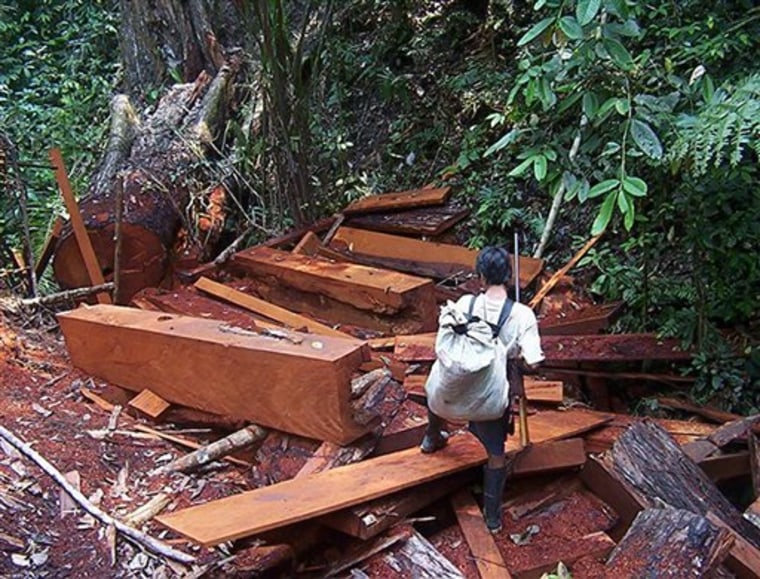Alberto Pizango Chota saw loggers come to his Indian village in the northern Amazon when he was 7. First they felled the mahogany. Then they returned to cut the cedars. By the time they came back for other hardwoods, there was little left of the forest.
Pizango says illegal logging also has endangered his Indian people — and the survival of primitive tribes who avoid all contact with other humans. Dozens of violent encounters with the tribesmen have been documented in the last five years.
"Sometimes they run away" from the loggers, said Pizango, now 42. "Some stay and defend their rights to the forest," pitting their arrows against 16-gauge shotguns.
Peru, the world's largest mahogany exporter, came under sharp attack this week at the Convention on International Trade in Endangered Species, or CITES, for setting unsustainable export quotas and for failing to rein in poachers in its national parks and forest reserves where Indians live.
"This wood has been dirtied with the blood of indigenous people," said Pizango, the chairman of the National Association of Amazon Indians in Peru, who appealed to CITES for help.
Fearing a total trade suspension, Peru agreed Saturday to reduce its quota from 13,000 cubic meters of mahogany to less than 5,000, or about 1,200 trees per year. It also reaffirmed its pledge to protect indigenous tribes.
But environmentalists said Peru's assurances should be treated with caution.
"There have been problems of verification," said Cliona O'Brien, senior policy analyst for the World Wildlife Fund for Nature, or WWF. "We need to keep a very close eye over the next year."
Peru already is under CITES trade suspension for violating restrictions in one species of parrot — the red masked conure, sometimes called cherry heads.
CITES is a 1975 treaty signed by 171 nations that oversees trade in plants and animals threatened by over-exploitation. It has more than 7,000 animals and 32,000 plants on its lists.
$100,000 trees
The incentives for illegal logging are great. Organized gangs pay workers a pittance to harvest trees worth about $1,800 per cubic meter on the market — or as much as $100,000 per tree, said Nils Hermann Ranum of Rainforest Foundation Norway.
In 2004, the Norwegian nongovernment agency reported 700 to 1,000 loggers were found in a reserve on the Las Piedras River set aside for indigenous people — not far from a police patrol post meant to protect the reserve from poachers.

Pizango, who was a teacher in his village of 210 residents before becoming chairman of his lobby group, said there is no more mahogany for the men of his village to build canoes or the walls of thatched-roof houses. He said logging is changing the social structure of isolated communities like his — a 10-hour boat trip down the Paranapura river to the nearest town.
But the invasion of loggers is far worse for the tribes who live in "voluntary isolation" and who are continually pushed deeper into the reservations.
In the past, contact with outsiders brought devastating diseases.
Rough estimates say they number from 2,000 to 10,000, but even Indians keep their distance for fear of infecting them. Most of what is known about these nomadic people is from their abandoned campsites.
Protecting tree species sooner
Environmentalists say mahogany has been depleted to "commercial extinction" in parts of Peru, Ecuador and Colombia, meaning the concentration of trees is so thin they are not worth harvesting. But mahogany has a wide range, and is not threatened with biological extinction.
Until now, CITES has been cautious about big-money issues, such fisheries and timber, focusing instead on species like the tiger and elephant that could vanish completely. It took 10 years after South American mahogany was first raised as a vulnerable tree before it came under CITES regulation.
CITES Secretary General Willem Wijstekers acknowledges that was a mistake.
"Timber species that have been included in CITES so far were at a far too late stage," he told the conference's ceremonial opening on Sunday.
Later during the conference, delegations will vote on a proposal to protect Spanish cedar, a tree grown across much of South America used for furniture and the aromatic lining of humidors.
"Now is the time for cedars," said O'Brien. "If mahogany had been listed when it was first suggested, we would have a lot more trees than we do now."
